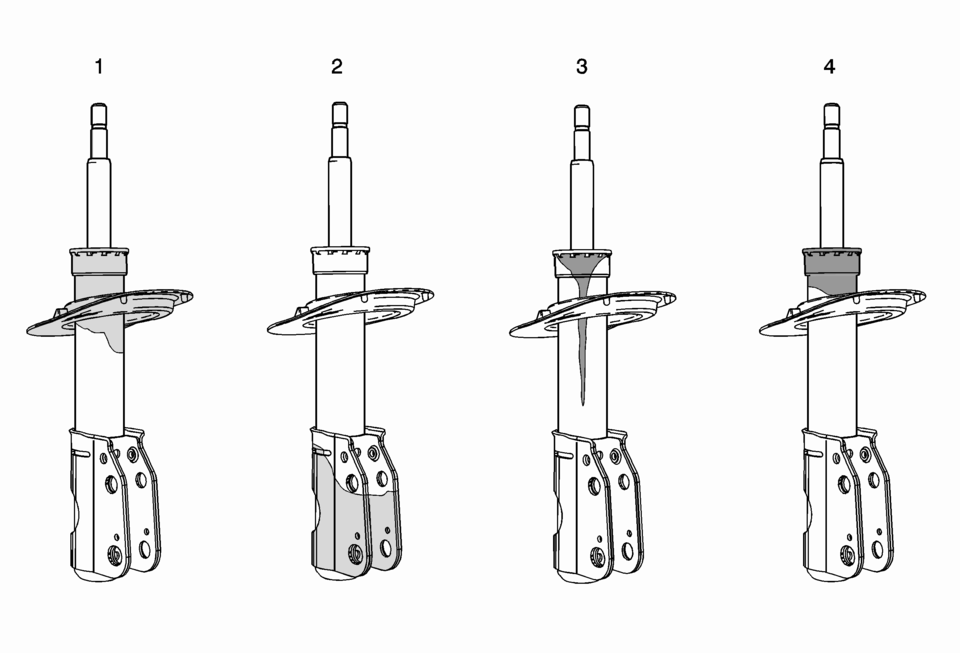Chevrolet Sonic Repair Manual: Strut and Shock Absorber Inspection
Note:
The strut assembly DOES NOT have to be removed from the vehicle to perform the following inspection procedure.
Note:
A light film of oil on the top portion of the strut is normal. DO NOT replace the strut for this condition.

Condition 1
Oil or fluid residue only on the bottom of the strut tube or on other strut components and not originating from the shaft seal, is not a strut related problem. DO NOT replace the strut, look for other external leaks.
Condition 2
Light film/residue on the strut tube, but not on the spring seat and originating from the shaft seal, is a NORMAL condition. DO NOT replace the strut.
Condition 3
Oil drip or trail down the strut tube and originating from the shaft seal, is an ABNORMAL condition. Replace the strut.
Condition 4
Extreme wet film of oil covering the strut tube and pooling in the spring seat and originating from the shaft seal, is an ABNORMAL condition. Replace the strut.
Inspection- Verify the customer's concern is present. If the concern is present, continue to the next step. If the concern is not present, then the vehicle is operating normally.
- Raise and support the vehicle. Refer to Lifting and Jacking the Vehicle.
- Visually inspect each of the shock absorbers or struts for external fluid leaks. Refer to the following conditions 1, 2 , 3 , and 4 for visual inspection.
Note:
The strut assembly DOES NOT have to be removed from the vehicle to perform the following inspection procedure.
- If conditions 1 or 2 are found, continue to step 4.
- If conditions 3 or 4 are found, replace strut. Refer to Strut Replacement.
 Shock Absorber Replacement
Shock Absorber Replacement
Shock Absorber Replacement
Callout
Component Name
Preliminary Procedure
Raise and support the vehicle. Refer to Lifting and Jacking ...
 Strut and Shock Absorber Inspection (Shock Absorber)
Strut and Shock Absorber Inspection (Shock Absorber)
Note: The shock absorber assembly DOES NOT have to be removed from
the vehicle to perform the following inspection procedure.
Note: A light film of oil on the top portion of the lower sho ...
Other materials:
Steering Knuckle Replacement
Removal Procedure
Raise and support the vehicle. Refer to Lifting and Jacking the Vehicle.
Remove the tire and wheel assembly. Refer to Tire and Wheel Removal
and Installation.
Remove the wheel speed sensor from the steering knuckle. Refer to Front
Wheel Speed Sensor ...
Differential Carrier Removal (6T40/45/50)
Differential Carrier Removal
Callout
Component Name
1
Front Differential Carrier Bearing Assembly
2
Differential Carrier Assembly
3
Final Drive Sun Gear
...
Engine Replacement (Automatic Transmission)
Special Tools
J-45859 Wheel Drive Shaft Remover
CH-807 Closure Plugs
For equivalent regional tools, refer to Special Tools.
Removal Procedure
Remove the battery and battery tray. Refer to Battery Tray Replacement.
Relieve the fuel system pressure. Refer to Fuel Pressur ...
0.0057
